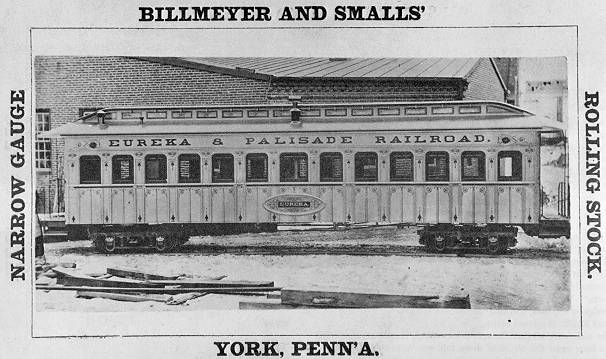Billmeyer & Small(s)
|
 |
|
Above is the heading of an advertising brochure dated February 1875 that illustrated a number of narrow gauge railway cars available from Billmeyer & Small, designated by letters of the alphabet, “so that in describing them they may more easily be recognized.” Below is an advertisement believed to date from the early 1870s. Note the plurality of the name “Small.” It is hard to say just how many members of the Small family were involved in the firm prior to its organization as a joint stock company {424} in 1876. We know David E. (D.E.) was, and the advertisement below indicates that his brother John (J.H.) was also. But this was a family business, and it is almost a certainty that other members of this extended and wealthy family were more or less involved also. The 1860 census lists no less than 13 individuals with the surname of Small whose occupations indicate they may have been involved in one capacity or another. |
 |
We do know that early in its existence the partnership became known as the York Car Works, and was located in York, Pennsylvania, near the Pennsylvania Railroad and the North Central Railway. Further, we know that it was called Billmeyer & Smalls’ [plural possessive] York Car Works (see advertisements above and below). Just how many members of the extended Small family were involved is hard to gauge. Looking at the 1850, 1860 and 1870 U.S. Census population schedules, the only Small for whom car building is specifically listed as occupation is David E. Small. But there are as many as 13 others who might have been involved in one way or another, from “Lumber Merchant” to “Carpenter” and “Painter”
During the Civil War, Confederate General Jubal Early moved north in late June of 1863, seizing the town of York without firing a shot. “Prominent and influential citizens” went forth to meet the Confederate troops and were given a “written article of agreement in which it was stated that upon their entering into York and its vicinity [the Confederate troops] would refrain from destroying private property and not molest women and children in their occupation but would expect a contribution of money and maintenance while there.” After occupying the town for several days, General Early began to complain that the needs of his troops were not being met fast enough, and threatened to burn the railroad shops and Billmeyer & Small’s [sic] shops, because they were “furnishing cars to the government.” But before he could do so, he received orders to withdraw and meet General Lee at a small town about 40 miles to the southwest called Gettysburg. And you probably know what happened there July 1-3, 1863! {203}
Early in 1871, the Denver & Rio Grande—the first major western narrow gauge railroad—ordered 100 single-truck (that is, 4-wheeled) freight cars especially-tailored to the 3-foot track gauge of their railroad then being built in Colorado. Later that same year, they began ordering 8-wheeled cars. On the basis of this new business, Billmeyer & Smalls announced plans to build a new shop building 60 feet by 170 feet exclusively devoted to building narrow-gauge cars. {204}
The York Car Works was started down the course of specializing in narrow gauge cars, of which they became one of the preeminent builders. This no doubt helped them to survive the several years of depression that followed the stock market crash of 1873 that dried up most existing markets for railroad cars.
A promotional piece headed by the advertisement above had illustrations of one or more cars for each letter of the alphabet; all kinds of cars, including their double drop bottom patent coal car, eight-wheeled gondola, third class or emigrant passenger car, combination second class passenger car, first class passenger car, four-wheeled side dump car, four-wheeled end dump car, first class baggage and express car, and on and on. Some of these are reproduced on the next page.
By 1875, cars were coming out of the 10-acre works at the rate of 40 to 50 four-wheeled cars and 20 to 30 eight-wheeled cars a week. 250 men were employed at the lumber mill and the wright mill. {26}
 |
|
The Eureka, built by Billmeyer & Small 1875 for the Eureka & Palisades Railroad. 41'-0" long, she seated 36 and weighed in at 8½ tons. |
Yes, Billmeyer and Smalls were still very much in the lumber, sash and door business. We have seen the advertisements for their lumber business in almost every issue of the Delta Herald newspaper from late 1883 until mid-1888. Eventually, they would employ 700 workers in the car works and at the planing mill at Wrightsville.